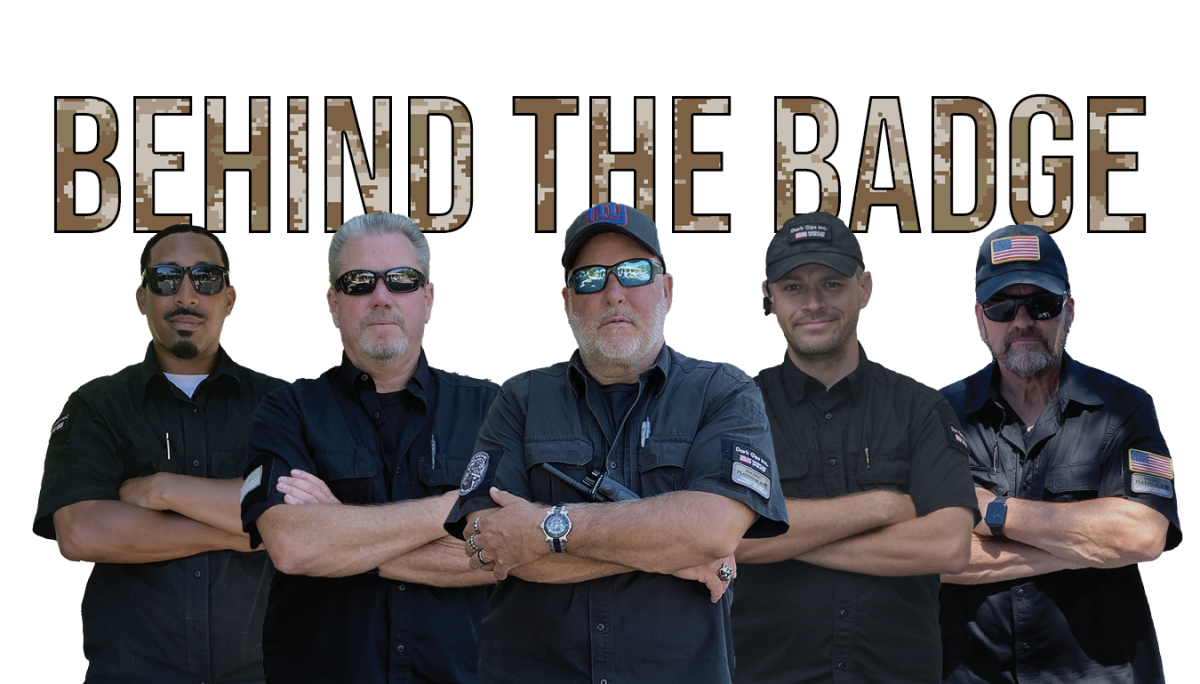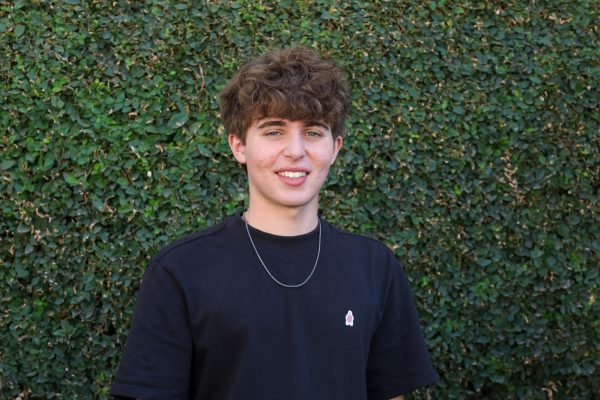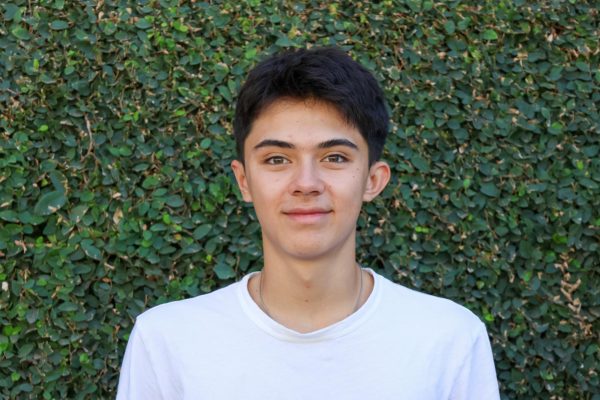It is 1:30 a.m. in Palmdale, CA. Head of Upper School Security Earl Saunders’ day just began. Before Saunders hops on his Harley-Davidson motorcycle an hour later, he checks in with his wife about their weekend schedule. Saunders plans to spend time with his 11 grandkids by attending a football game, a dance recital and a birthday party.
As his bright headlights illuminate the open road, Saunders thinks back to his recent motorcycle trip where he hit 100,000 miles on his bike. After pulling into the empty school parking lot, Saunders finds a spot to sit down and relax for a few hours before beginning his shift at 6:30 a.m. With a smile and a wave, Saunders greets upper school students, parents, faculty and staff at the main entrance of the Upper School each morning.
“It’s very important when you work up there,” Saunders said. “You greet the students coming in, but you’re also looking at the people coming in and making sure you recognize everyone. If there’s someone or a vehicle I don’t recognize, I’ll ask one of the [guards] to identify him and make sure nobody is on campus that doesn’t belong.”
Out of high school, Saunders said he planned to attend a police academy until he found out he had received too many speeding tickets on his motorcycle. Instead, Saunders attended the California Department of Corrections Academy before working at the California State Rehabilitation Center in Norco, CA. Saunders said through working in a prison, he learned how to exert his authority while still respecting inmates.
“In the prison system, kindness can be considered a weakness,” Saunders said. “You have to be fair but a little bit rigid. When I started, I was the youngest [peace officer], and I had a shaved head. When I used to walk through the dorms with 100 or 200 criminals, I would hear comments like ‘Go back to high school’ or ‘Why do they let kids work in prisons?’ because I looked so young.”
Saunders worked in the prison system for over 30 years in both minimum and maximum security environments. Saunders has worked a range of jobs, from driving prison buses to extraditing inmates who skipped parole and fled to other states. Despite the many differences between his role in prison and at school, Saunders said his core principles remain constant.
“You have to change a little bit of your perspective,” Saunders said. “It’s still all about respect, whether [you are] talking to criminals or students who are trying to further their education and go to bigger and better things. I never disrespected [an inmate] regardless of what he was in prison for. I always came at him straight and honest. It’s the same [principle] with students. If a student asks me something, I’m gonna tell them yes or no whether they like the answer or not. Honesty, respect and having manners go a long way when you’re dealing with people, regardless of how old or young they are.”
Like Saunders, Head of Security Jim Crawford aspired to be a police officer but also had some speeding tickets in high school. Crawford grew up watching the TV show “Adam-12” and was inspired by two police officers patrolling Los Angeles. At 19 years old, Crawford started to work part-time security at Harvard School for Boys. He then joined the Los Angeles Police Department for 26 years before taking over as Head of Security in 2006. Crawford said former Headmaster Thomas Hudnut stressed the importance of having trained professionals as security guards.
“Hudnut had hired us on, and he insisted on having law enforcement there, because of the range of skill sets that policeman had,” Crawford said. “Whether communicating with people or dealing with different situations, he wanted trained guys and girls to work for the school [because] we provide more for the school than just being a rigorous security guard.”
Building on Hudnut’s guidance, Crawford said he has continued to only hire current or former law enforcement, military or prison guards to work as security guards.
“I don’t hire guys from a website, I hire guys that I know because I need a certain skill set from those guys and girls,” Crawford said. “I recruit from within, from guys and girls that work for me now that they refer me to people that I do background checks on. I make sure that they’re not troublemakers, [and] that they don’t have anything in there that is different than what I expect a policeman to be. I don’t want people that are that are prejudiced. I don’t want people that have grudges and that can’t cope with how things are in today’s times.”
Upper School Security Guard Tony Tutino spent most of his 30-year career in the Ventura County Sheriff’s Department before retiring. After spending some time at home, Tutino said he wanted to return to the workforce, leading him to look for job opportunities. Tutino said he has grown close with Saunders throughout their time working together at the school.
“Earl and I are together a lot so we make a pretty good team,” Tutino said. “We’re both two peas in a pod [and] exactly alike, in a lot of ways. We definitely look intimidating to a lot of people, but in reality, we’re not. We’re very approachable, but if you’re doing something wrong and trying to get away with it, it’s not going to be good.”
During the day, Saunders and his team members walk throughout the campus to make sure that they don’t see anything out of place, reinforced by the camera system that is monitored by Tutino. Crawford said the cameras are used only in common areas, entrance and exit points.
“We don’t put cameras in classrooms because we don’t want our students or faculty to think they’re being spied on,” Crawford said. “It’s more of a deterrent. They’re little dome cameras outside everywhere and we have some cameras that move so you can see them on the rooftops. We’ve got about 40 to 50 cameras on each campus and they are monitored 24/7. They’re covering critical, main traveled areas so we can track down people and things.”
Another protocol that security has implemented in order to protect the community is the Alert, Lockdown, Inform, Counter, Evacuate (A.L.I.C.E.) program. Following the school shooting at Columbine High School in 1999, Crawford and Security Guard Mark Geiger started researching different programs to protect the school in case of an attack. They ultimately decided on A.L.I.C.E. following a rigorous four-day training in Texas. Crawford said the training equips students with some necessary tools to defend themselves in the event of an active shooter on campus.
“If a gunman came into a classroom, let’s teach our young people what to do instead of just [sitting] there and [getting] shot,” Crawford said. “Let’s teach them how to fight back. Let’s give them some skills that can better their odds. If there’s a shooting on campus, we want you out of that classroom and off that campus.”
Since the protocol was implemented, many students have undergone training in a specially designed room to simulate the scenario of an active shooter. Amber Zhang ’25 participated in the training during her sophomore year and said the protocol will help students in the event of a gunman on campus.
“I would definitely say it’s beneficial,” Zhang said. “I have full faith in the security guards. It’s good to know that we all know what to do in case of an emergency. I think that everyone would benefit from the training because there’s a possibility that it is going to happen, and if it does, it’s better to be overprepared than underprepared.”
Every student interacts with security at some point in the day, by either checking in, leaving at the end of the day or simply saying hello. Tanya Anand ’24 said the security guards are always flexible when she needs help.
“The security guards are really nice people, and they’re always so helpful,” Anand said. “A lot of times I need to leave slightly early for tennis and sometimes my app won’t let me check out, but the security guards are always so accommodating.”
Saunders said he enjoys connecting with students because of the unique capabilities and interests they have.
“High school students are at the age where [they’re] able to interact with them a lot more because you might have things in common with them,” Saunders said. “Whether it be sports, art, music or anything else. Every student is different so you’re always learning something new. I’m still constantly learning stuff that I didn’t know about all this cell phone technology.”
Beyond individual connections with students, Crawford said his team strives to support students by keeping the community protected.
“Our goal is to make sure that [students] have a safe working environment,” Crawford said. “On our patches, it says ‘protecting our greatest resource’ which is the students. They’re the future, so we want to make sure that they have a safe working environment and you carry on the stuff that we’ve been doing all our lives. We can only hope that you all guide the country to be strong, healthy and safe.”





























